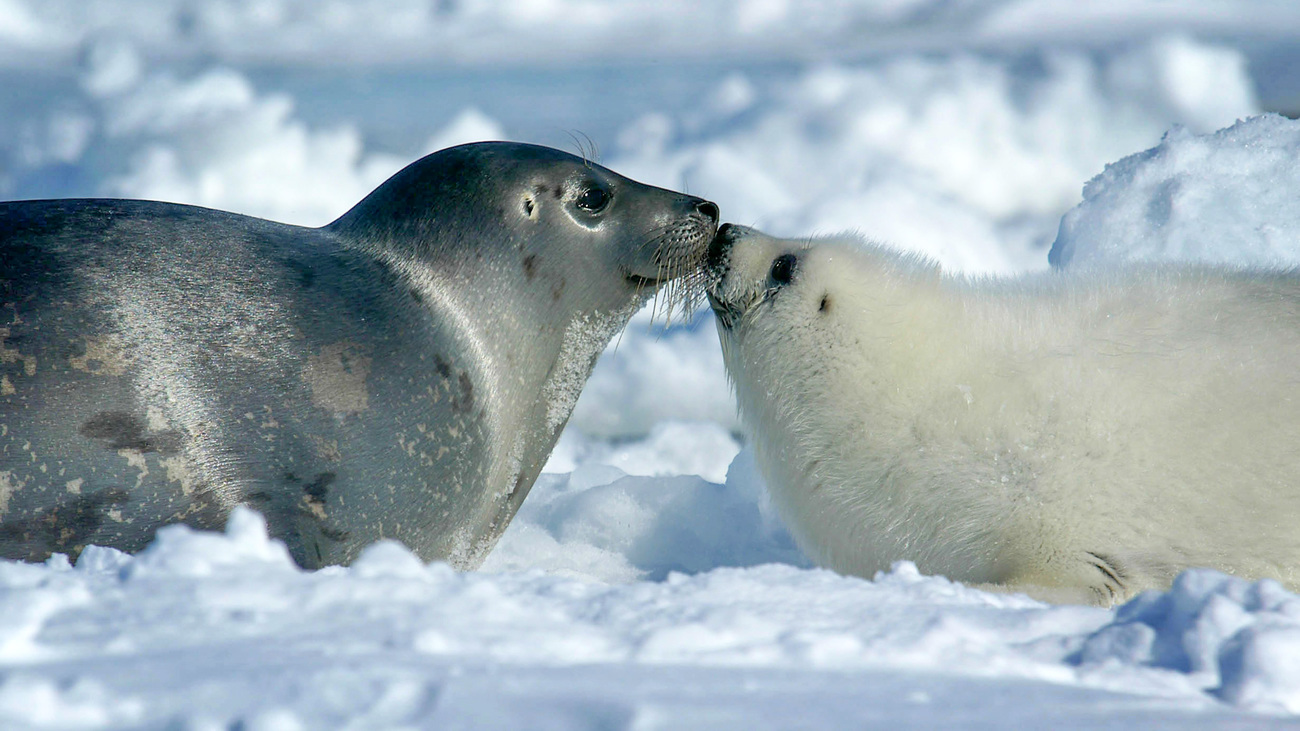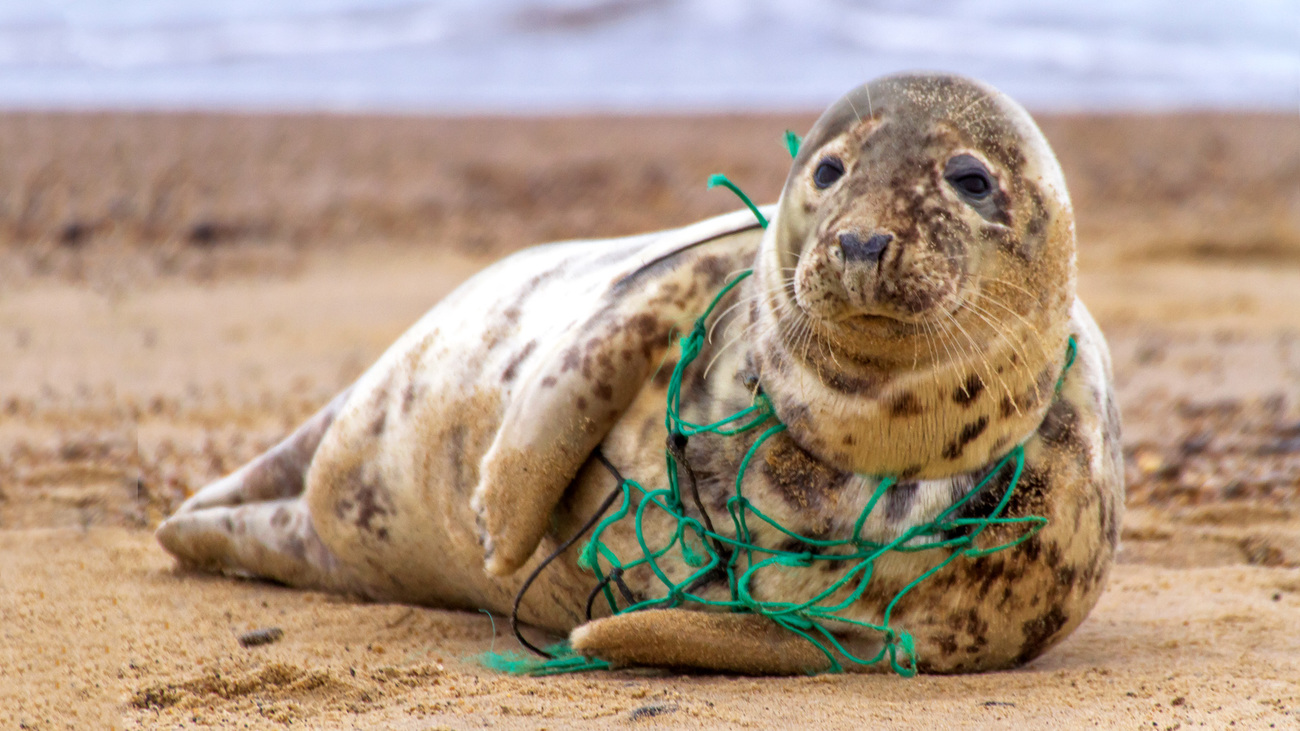Entangled Seal Rescue - North America
Fishing nets don’t just trap, they killSeals are semi-aquatic mammals, also known as pinnipeds. These are the only marine mammals that feed in water and breed on land.
Like many aquatic animals, seals face several threats to their survival, including climate change, entanglement, and commercial hunting.

IFAW is working to protect seals, marine ecosystems, and other wildlife around the world, creating a future where animals and people can thrive together. Working alongside local partners and communities, our marine conservation initiatives protect our oceans and the abundant biodiversity beneath the waves.
If you want to learn more about seals, you’re in the right place. Here, we answer a host of FAQs about seals and dive into some incredible seal facts.
How many seal species are there?
There are 33 species of seals. These species vary in size and appearance, and they include:
- Leopard seals (Hydrurga leptonyx)
- Harp seals (Pagophilus groenlandicus)
- Baikal seals (Pusa sibirica)
- Northern elephant seals (Mirounga angustirostris)
- Southern elephant seals (Mirounga leonine)
- Crabeater seals (Lobodon carcinophaga)
- Grey seals (Halichoerus grypus)
- Hooded seals (Cystophora cristata)
Seal species generally fall into two categories: earless seals (also known as ‘true seals’) and eared seals.
Earless seals are members of the Phocidae family. They’re called earless seals because they have no visible ear flaps, although they do still have ears.
Eared seals (which include sea lions and fur seals) are members of the Otariidae family. Eared seals have visible ear flaps and longer flippers than earless seals. Their fur is also more visible than the fur of earless seals.
Where do seals live?

Seals can be found worldwide, although many prefer to live in the colder waters of the Arctic and Antarctic oceans.
Some seal species live in the open ocean, while others prefer coastal waters and spend their time within easy reach of islands, beaches, or ice floes.
The Baikal seal is the only seal that doesn’t live in seawater. This small seal lives in Russia in Siberia’s freshwater Lake Baikal.
How big is a seal?
A seal’s size depends on its species.
Baikal seals are the world’s smallest seal species. They measure around 1.1 to 1.4 metres (3.6 to 4.6 feet) and weigh 50 to 130 kilograms (110 to 290 pounds).
Southern elephant seals, which are primarily found in the Antarctic Ocean, are the largest seals. They can reach 6.5 metres (21 feet) long and weigh up to 3,700 kilograms (8,150 pounds).
Male seals tend to be much larger than female seals. In fact, male elephant seals can weigh 8-10 times more than females, making elephant seals the most sexually dimorphic mammals on Earth.
How deep can seals dive?
Seals can dive deep into the ocean. Elephant seals have been known to swim to depths of around 2,400 metres (7,800 feet).
But like all other mammals, seals need to come to the ocean’s surface to breathe. The elephant seal can stay underwater for around 100 minutes without taking a breath. This rivals the time between breaths for many whales.
What do seals eat?
Seals are carnivores, and they mainly eat fish. Some seals consume squid, molluscs, and crustaceans. Despite its name, the crabeater seal eats krill, not crabs. And unlike other seals, leopard seals feed on penguins, seabirds, fish, krill, and other seal species.
Seals are also prey for a variety of predators, including polar bears, orcas, and large sharks.
Seals’ blubber serves multiple purposes
Seals don’t need to eat every day. They have a layer of blubber that stores fat, allowing them to go for extended periods without eating. Their blubber also helps insulate them as they swim in cold waters and acts as a buoyancy aid.
Why do seals have whiskers?
Both seals and sea lions have lots of whiskers on their faces. The way they use their whiskers is similar to how cats use them. Seals’ whiskers help them detect water vibrations, particularly those caused by swimming prey.
Galumphing: seals’ movement on land
Seals are much more graceful in the water than they are on land. When seals move on land, it's called galumphing, and they move by flopping along on their bellies in an undulating motion, a bit like a caterpillar.
Seals’ ancestors walked on land
There are fossil records indicating that the ancestors of the modern seal entered the ocean around 28 to 30 million years ago.
Scientists think that true seals, the family Phocidae, may have descended from a type of land-living weasel, whereas eared seals, the family Otariidae, may have descended from a bear-like ancestor.
What is a baby seal called?

A baby seal is called a pup. Female seals are pregnant for around 11 months, and they give birth to their pups on land, on sea ice, or in the water. Seals nurse their young with milk that is up to 50% fat, feeding their pups for up to a month until they’re strong enough to swim independently.
Most seal mothers don’t leave their pups during this period and don’t eat anything themselves. Instead, they rely on their stores of blubber to survive.
Harbour seals, also known as common seals, are an exception. Mother harbour seals leave their pups on the shore to feed in the water. When they return to land, they identify their pup by scent. Harbour seal pups can also call to their mothers. They make a distinctive call that can be heard up to one kilometre (1,000 yards) away.
Some seals sleep while diving
Seals can sleep underwater as well as on land. In the water, they can sleep floating in a vertical position or floating horizontally near the surface.
While hunting at sea during a period that can last for up to eight months, elephant seals sleep for 10-minute bursts while performing deep, 30-minute dives. They spiral downwards while asleep and sometimes lie down to nap on the seafloor.
During this time at sea, seals average just two hours of sleep per day, but they make up for it when they’re back on land. Out of the water, elephant seals can sleep for over 10 hours per day.
How do seals communicate?
Like other marine mammals, seals usually communicate vocally, using calls and whistles. Male grey seals also clap their flippers underwater during the breeding season to warn off other males and attract female mates.
Seals live solo, except during mating season
Seals tend to live solitary lives and are only seen in large numbers during pupping and mating seasons. During the mating season, many seals come to shore to breed. A group of seals is known as a colony.
Male seals—known as bulls—can be aggressive towards one another during this time. Because only a select few males get the right to breed, they fight for control of their territory and their females—known as cows.
They use vocalisations to intimidate other males. Elephant seal fights can be particularly violent and bloody. Males sometimes remain on land for months, forgoing feeding to guard their territory.
Seals live much of their lives on land
Seals are semi-aquatic, meaning they spend part of their lives in water and part of their lives on land. The process of coming ashore is called ‘hauling out’.
Seals rest on land to regulate their body temperature, breed, give birth, and nurse their young. They sometimes come onto land to escape aquatic predators, like orca whales and sharks.
Some seals also spend a lot of time on land when they moult. This is when they shed their old fur, replacing it with a healthy, shiny new coat. Seals moult once a year, usually after the pupping season.
What do you do if you find a seal on a beach?
Seals are wild animals and should not be approached for your safety and theirs. They are not naturally friendly to humans. Seals have sharp teeth and strong jaws and will bite if they feel threatened.
Experts recommend that you observe seals, on land or at sea, from a distance of at least 46 metres (150 feet), and if you have a dog with you, you should keep it on a leash.
Seals spend time on land to rest, suckle their young, and digest their food. So, if you disturb them, you can interrupt these processes and cause them unnecessary stress.
Remember that seals spend a lot of time on land—and most species spend time alone. Some seals even leave their newborn pups on a beach while they search for food, so there’s every chance a baby seal is just waiting for its mother to return.
Also, remember that seals do not need to always be wet. They regularly spend days on land to take a break from swimming and warm up in the sun.
But sometimes, a seal on a beach may need help. Entanglement in fishing gear and marine litter is a big threat to seals. If you are worried about a seal on a beach, call a local stranding response organisation rather than approaching the animal yourself. You can talk to a marine mammal responder about the sighting, and they can help determine whether the seal is stranded and in need of help or whether it’s safe to leave the animal alone.
Are seals endangered?

Both the Japanese sea lion and the Caribbean monk seal became categorised as extinct in the 1980s and 1990s, having had no confirmed sightings for the past 50 years. Six total seal species are currently listed as endangered on the IUCN Red List:
- Galápagos fur seals
- Hawaiian monk seals
- New Zealand sea lions
- Caspian seals
- Australian sea lions
- Galápagos sea lions
There are only about 632 Hawaiian monk seals remaining in the wild.
Seals face a number of threats in the wild, including commercial hunting. Historically, seals have been hunted for their meat, fur, and blubber—and they are still hunted in some countries, including Canada.
Fishing also poses risks to seals. They can become entangled in discarded fishing gear and caught by fishermen as bycatch.
Climate change is another big threat, particularly for seal species that rely on sea ice. Melting sea ice causes seal pups to be separated from their mothers too soon. It also puts seals at greater risk from predators.
How can you help IFAW protect seals?
IFAW was founded on the mission of ending the commercial seal hunt in Canada. We travelled to the ice to observe and document the annual slaughter, bringing international media, politicians, and veterinary experts with us to observe the cruelty first-hand. Since then, our work has helped bring about monumental changes like the 2009 EU ban on seal products. This ban saved over one million newborn seals in the following 10 years. We continue to urge the Government of Canada to adopt sustainable alternatives to the commercial seal hunt to support the economy and local communities while protecting seals.
On Cape Cod, our Marine Mammal Rescue & Research team is revolutionising how we rescue seals. One method to rescue entangled seals, developed in partnership with The Marine Mammal Center in California, involves using a sedative dart with a specialised tracker embedded, which enables our team to capture, disentangle, and treat seals. We can minimise the suffering of seals, release them back to the ocean, and share our expertise with marine mammal rescue networks worldwide. We also promote coexistence with seals by working with communities to ensure that beachgoers can appreciate the animals at a safe and healthy distance, minimising additional human impact.
Help IFAW end the commercial seal hunt in Canada. Sign the petition >>
Related content
Our work can’t get done without you. Please give what you can to help animals thrive.